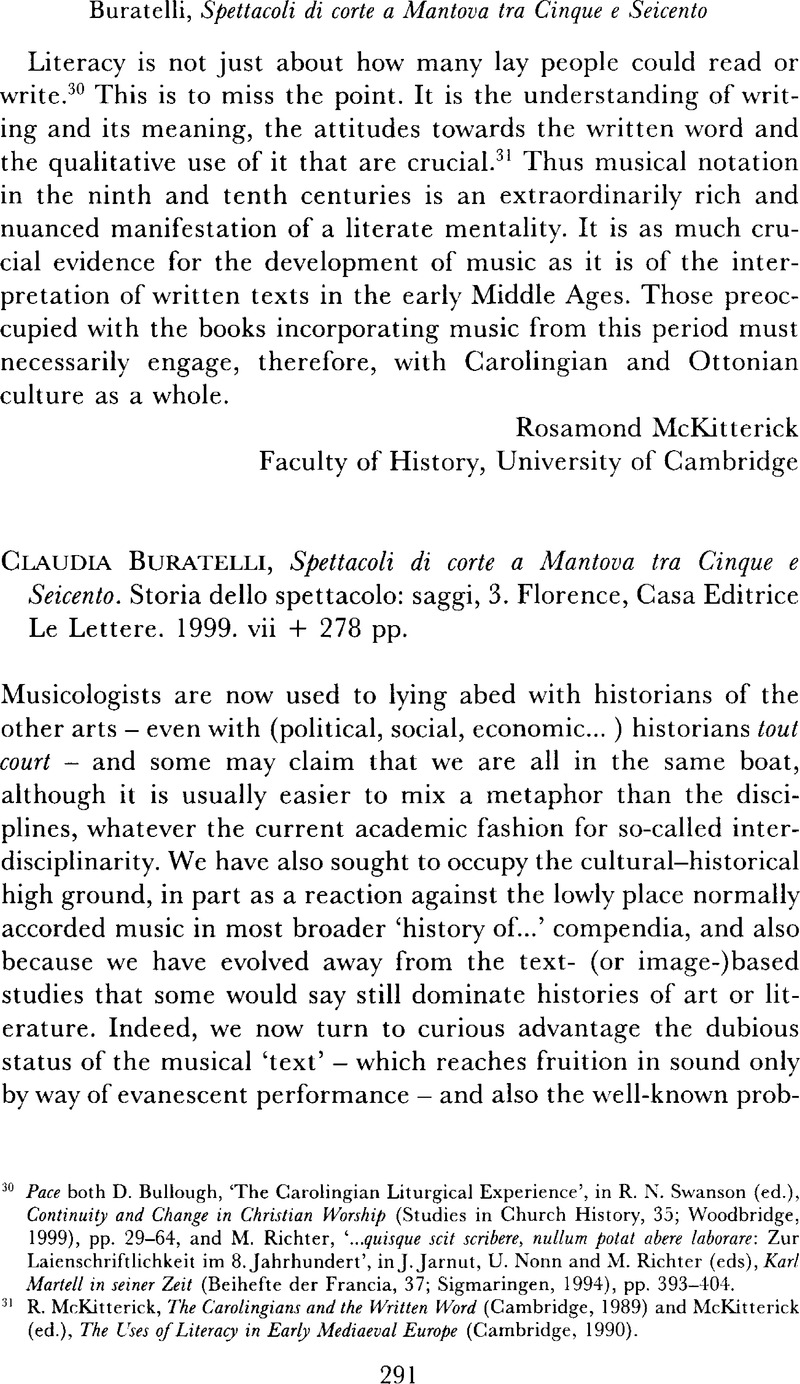No CrossRef data available.
Published online by Cambridge University Press: 05 December 2008

1 Pirrotta, N., Li due Orfei (Turin, 1969, 2nd edn 1975)Google Scholar; Music and Theatre from Poliziano to Monteverdi, trans. Eales, K. (Cambridge, 1982)Google Scholar.
2 Adimari, A., La bell'Adriana ed altre virtuose del suo tempo alia corte di Mantova (Citta di Castello, 1888)Google Scholar; Bertolotti, A., Musici alia corte dei Gonzaga in Mantova dal secolo XV al XVIII: notizie e documenti raccolti negli archivi mantovani (Milan, 1890; repr. Bologna, 1969)Google Scholar; Solerti, A., Gli albori del melodramma (Milan, 1904; repr. Bologna, 1976)Google Scholar.
3 Fenlon, I., Music and Patronage in Sixteenth-Century Mantua (Cambridge, 1980, 1982)Google Scholar; Parisi, S. H., ‘Ducal Patronage of Music in Mantua, 1587–1627: An Archival Study’ (Ph.D. diss., University of Illinois at Urbana-Champaign, 1989)Google Scholar; Harran, D., Salamone Rossi: Jewish Musician in Late Renaissance Mantua (Oxford, 1999)Google Scholar.
4 Mantua, Archivio di Stato, Archivio Gonzaga, busta 2577, fol. 23r.
5 But for a rounder view, see Besutti, P., ‘Da L'Arianna a La Ferinda: Giovan Battista Andreini e la “comedia musicale all'improviso”’, Musica disciplina, 49 (1995), pp. 227–76Google Scholar.
6 See Fenlon, I., ‘The Origins of the Seventeenth-Century Staged Ballo’ in Fenlon, I. and Carter, T. (eds), ‘Con chesoavita’: Essays in Italian Baroque Opera, Song, and Dance, 1580–1740 (Oxford, 1995), pp. 13–40Google Scholar; Carter, T., ‘New Light on Monteverdi's Ballo delle ingrate (Mantua, 1608)’Google Scholar, Il saggiatore musicale (forthcoming).
7 Archivio Gonzaga, busta 2231, unfoliated.
8 Ibid.
9 They were included in d'Ancona, A., Origini del teatro italiano (2nd edn, Turin, 1891), ii, pp. 424–5Google Scholar. D'Ancona presents many of the documents discussed by Buratelli.
10 For Andreini's impact on Arianna, see Carter, T., ‘Lamenting Ariadne?’, Early Music, 27 (1999), pp. 395–405CrossRefGoogle Scholar. The preparations for the ‘egloga’ (elsewhere called a 'ballo') Apollo (to a text by Alessandro Striggio) are discussed in Fabbri, P., Monteverdi, trans. Carter, T. (Cambridge, 1994), pp. 171–4CrossRefGoogle Scholar; it seems to have received two performances in Mantua, one in late February or early March 1620 and the other the following summer; parts of it were also heard in Venice. Buratelli (p. 230, n. 1) cites a letter from Virginia Andreini of 22 April 1623, perhaps to Alessandro Striggio (Archivio Gonzaga, busta 2761, no. 216), in which Andreini refers to ‘that feeble service which I then did for you who deigned to have me do [the role of] Dafne in your most gracious balletto’. We know from Monteverdi's letters that Apollo included the characters Apollo (who had a lament), Amor and Peneius (Daphne's father; sung by a bass singing alla bastarda), and Daphne is, of course, central to the Apollo myth.
11 See Cusick, S., ‘“There was not one lady who failed to shed a tear”: Arianna's Lament and the Construction of Modern Womanhood’, Early Music, 22 (1994), pp. 21–41CrossRefGoogle Scholar; MacNeil, A., ‘Weeping at the Water's Edge’, Early Music, 27 (1999), pp. 406–17CrossRefGoogle Scholar.